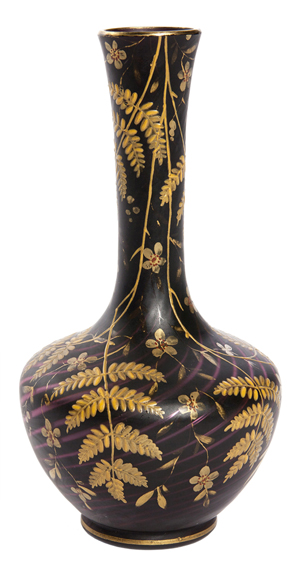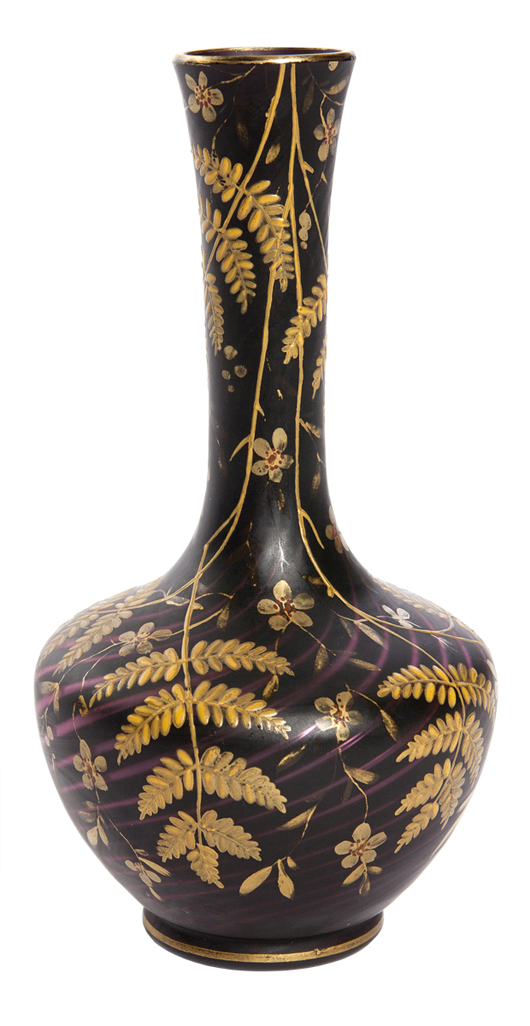
BEACHWOOD, Ohio – Most people have heard about the bout of “Tulipmania” that spread through the Netherlands in the 17th century, but few know about “Pteridomania,” or fern madness.
In the 19th century, ferns were part of a popular health regimen. People would go into the woods to hunt for ferns or to study nature. It was good exercise for body and soul. People from all levels of society joined in searching for new varieties of ferns they could record, plant or dry and put in albums.
The many varieties of ferns were soon featured on porcelains and iron garden furniture, and in paintings and interior decors. Green majolica plates shaped like fern leaves, iron benches by Coalbrookdale and children’s toy porcelain dishes by Ridgways were decorated with ferns. The madness continued into the 1880s, but even today ferns are popular house and garden plants. More than 10 varieties are offered in new mail-order garden catalogs, and even more can be found in nurseries in cities with a fern-friendly climate. It would be easy to find decorative examples of Pteridomania and form a collection today.
Q: I’m 92 years old and am trying to get rid of some old possessions. A copy of the April 20, 1865, Philadelphia Inquirer has been in my family for ages. The front page has several articles about President Abraham Lincoln’s funeral. There are drawings (not photographs) of the funeral car and coffin. I’d like to sell it but don’t know the value. Can you help?
A: Newspapers covering the death of President Lincoln are collectible. The value of old newspapers varies, depending on the importance of the historical event covered as well as condition and rarity. A front-page article with graphic art is more important than articles on inside pages or those without pictures. Before photography was commonly used, illustrations were made from woodcuts. Some newspapers that are old but don’t cover significant events sell for under $10, while newer papers covering important events can sell for hundreds of dollars. Old newspapers become yellow and crumble if not stored properly, but newspapers printed on paper made from rag linen, common before 1876, don’t deteriorate as quickly as those made on modern paper. Newspapers should be stored flat and away from light, heat and moisture. Don’t store them in the attic or basement. Newspapers with stories about Lincoln have sold in recent years for $10 to a few hundred dollars, depending on condition and content.
Q: I was given an antique secretary, but the desk section is locked and I have no key. How can I open it without ruining the lock?
A: Don’t try to pick the lock. Call a few professional locksmiths and find one who is comfortable working with an antique lock. You will find someone who can open it safely.
Q: I have a tea cart that my parents bought in England in the early 1950s. It has been used by our family ever since, but not for serving tea. It’s on wheels and has two removable trays. There are two metal tags on the rail. One reads, “Staples Trolley, Prov Patent 22852/52.” The other reads, “Made by Staples & Co. Ltd., Wire Mattress & Bedstead Maker to the late King George VI.” Can you tell me how old the tea cart is, and if it has any value?
A: The patent is a United Kingdom patent dated June 12, 1952, for improvements to “tea trolleys, dinner wagons and like dispensing trolleys.” Your tea trolley was made shortly before your parents bought it in the 1950s. A tea trolley is what the English call a tea cart or tea wagon, a wheeled cart that usually has two shelves and can be pushed from room to room. It’s handy for transporting dishes or food from kitchen to table and back. The patent lists Staples & Co. Ltd. and Robert Garnett Heal as applicants. Staples & Co. was founded by Harold Heal and received a royal warrant of appointment as wire mattress and bedstead maker in 1923. Wooden trolleys from the 1950s sell for about $200 to $600, depending on design and condition.
Q: My old creamer is marked with the outline of what looks like Ohio and the words “Leigh Ware by Leigh Potters, Inc., U.S.A.” inside. Underneath that it reads, “Patent applied for, warranted 22K gold.” Is this worth anything?
A: Leigh Potters was in business in Alliance, Ohio, from 1926 to 1931. The company’s mark is outlined by the shape of the state of Ohio. Leigh Potters made dinnerware, kitchenware and decorative art ware. Your creamer is part of a set of dishes and has a low value if it’s not partnered with the sugar bowl. Price: under $20.
Q: Can you give me any information about a “John Bull” chess set made in India? The elaborate carved ivory pieces are British soldiers versus Indian Raj soldiers. I never see them for sale on the Internet.
A: Sets like yours usually are referred to as “John Company” sets because that was the nickname for the British East India Co. The origins of the game of chess can be traced to India before the sixth century, and the game continues to be very popular there. During the British Raj (British rule) from 1858 to 1947, many sets with ivory pieces—some elaborate and some simple—were made. The value of yours depends on how elaborately it was carved and what condition the pieces are in. Sets that predate 1989 can sell for very high prices. That’s the year a worldwide ban on the sale of ivory was implemented. But you won’t see the sets for sale on eBay. It will not allow the sale of any ivory on its site. If you want to sell, contact a reputable auction house.
Tip: For best results, schedule your house sale at the beginning or middle of the month (near paydays), but not during holiday weekends.
Sign up for our weekly email, “Kovels Komments.” It includes the latest news, tips and questions and it’s free if you register on our website. Kovels.com has lists of publications, clubs, appraisers, auction houses, people who sell parts or repair antiques and more. Kovels.com adds to the information in this column and helps you find useful sources needed by collectors.
Terry Kovel answers as many questions as possible through the column. By sending a letter with a question, you give full permission for use in the column or any other Kovel forum. Names, addresses or email addresses will not be published. We cannot guarantee the return of any photograph, but if a stamped envelope is included, we will try. The volume of mail makes personal answers or appraisals impossible. Write to Kovels, Auction Central News, King Features Syndicate, 300 W. 57th St., New York, NY 10019.
CURRENT PRICES
Current prices are recorded from antiques shows, flea markets, sales and auctions throughout the United States. Prices vary in different locations because of local economic conditions.
Hummel figurine, “Let’s Sing,” No. 110/4, 3 inches, $15.
Silver pin, openwork flowers, amber, oval mount, Continental, circa 1900, 1 1/4 inches, $60.
Bellows, leather, cornucopia and leaf design, 18 inches, $135.
Pepsi-Cola cardboard sign, “More Bounce to the Ounce,” woman holding tray picturing bottle cap, 1940s, 12 5/8 x 29 inches, $255.
Cartier pin, gold, rope knot, 1 3/4 inches, $295.
Regency-style etagere, ebonized, gilt, shelves, pierced brass gallery, turned uprights, 74 x 17 inches, $675.
Newcomb Pottery pitcher, jonquils, blue, green, white, matte glaze, Anna Frances Simpson, 1927, 5 1/2 inches, $800.
Side table, rectangular top, banded, stretcher shelf, square legs, fret-carved feet, circa 1900, 32 x 17 inches, pair, $1,105.
Coin-operated target game, Big Game Hunter, 1 cent, A.B.T. Manufacturing Co., key, 10 1/2 x 18 inches, $1,650.
Bronze sculpture, rabbit, ears down, Blue John Stone cube pedestal, attributed to Antoine-Louis Barye, 3 1/8 x 2 inches, $2,870.
Keep up with changes in the collectibles world. Send for a free sample issue of our 12-page, full-color newsletter, “Kovels on Antiques and Collectibles,” filled with prices, news, information and photos, plus major news about the world of collecting. To subscribe at a bargain $27 for 12 issues, write Kovels, P.O. Box 8534, Big Sandy, TX 75755; call 800-829-9158; or subscribe online at Kovelsonlinestore.com.
© 2013 by Cowles Syndicate Inc.

ADDITIONAL IMAGE OF NOTE


